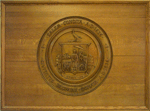Dow, George Francis: Difference between revisions
No edit summary |
No edit summary |
||
| (5 intermediate revisions by the same user not shown) | |||
| Line 3: | Line 3: | ||
the moving of first period house the "John Ward House" and the creation of [[Pioneer Village]] for the 300th Anniversary of the founding of Salem. | the moving of first period house the "John Ward House" and the creation of [[Pioneer Village]] for the 300th Anniversary of the founding of Salem. | ||
Joseph Everett Chandler, an architect, and Dow conceived Pioneer Village | Joseph Everett Chandler, an architect, and Dow conceived Pioneer Village as a means to demonstrate life in 1630. Noted landscape architect Harlan Page Kelsey drew up the landscape plan. | ||
Philip Horton Smith planned the restoration of the Ruck House. Together they created one of American's first living history museums. | Philip Horton Smith planned the restoration of the Ruck House. Together they created one of American's first living history museums. | ||
| Line 9: | Line 9: | ||
Dow was a member of the Massachusetts Historical Society, the New England Historic Genealogical Society and many other history societies. | Dow was a member of the Massachusetts Historical Society, the New England Historic Genealogical Society and many other history societies. | ||
He was director of Essex Institute and editor of its publications. He also edited the four volume "Diary of William Bentley". | He was director of Essex Institute for 20 years, and editor of its publications. He also edited the four volume "Diary of William Bentley". | ||
He wrote many non-fiction titles including books on Pirates, Whaling, and Arts & Crafts of New England. | He wrote many non-fiction titles including books on Pirates, Whaling, and Arts & Crafts of New England. | ||
He married Alice G. Waters in 1920, for many years librarian of the Essex Institute. | He married Alice G. Waters in 1920, who for many years was the librarian of the Essex Institute. | ||
Another important project for Dow was the restoration of the Parson Capen House in Topsfield | Another important project for Dow was the 1913 restoration of the Parson Capen House in Topsfield. | ||
| Line 25: | Line 25: | ||
[https://www.americanantiquarian.org/proceedings/44806934.pdf Obituary of George Francis Dow] American Antiquarian Society | [https://www.americanantiquarian.org/proceedings/44806934.pdf Obituary of George Francis Dow] American Antiquarian Society | ||
[https:// | [https://salem.noblenet.org/Record/2163000 Every day life in the Massachusetts Bay Colony] G.F. Dow, 1935. | ||
[https:// | [https://salem.noblenet.org/Record/1497863 Whale ships and whaling: a pictorial history of whaling during three centuries, with an account of the whale fishery in colonial New England, 1925] G. F. Dow, 1925. | ||
[https:// | [https://salem.noblenet.org/Record/2049236 The John Ward House] Essex Institute, 1976 | ||
Latest revision as of 18:12, 9 October 2025
George Francis Dow (Jan.7,1868-June 5, 1936) was a leading New England historian and antiquarian who was instrumental in two Salem projects,
the moving of first period house the "John Ward House" and the creation of Pioneer Village for the 300th Anniversary of the founding of Salem.
Joseph Everett Chandler, an architect, and Dow conceived Pioneer Village as a means to demonstrate life in 1630. Noted landscape architect Harlan Page Kelsey drew up the landscape plan.
Philip Horton Smith planned the restoration of the Ruck House. Together they created one of American's first living history museums.
Dow was a member of the Massachusetts Historical Society, the New England Historic Genealogical Society and many other history societies.
He was director of Essex Institute for 20 years, and editor of its publications. He also edited the four volume "Diary of William Bentley".
He wrote many non-fiction titles including books on Pirates, Whaling, and Arts & Crafts of New England.
He married Alice G. Waters in 1920, who for many years was the librarian of the Essex Institute.
Another important project for Dow was the 1913 restoration of the Parson Capen House in Topsfield.
See Also
Obituary of George Francis Dow American Antiquarian Society
Every day life in the Massachusetts Bay Colony G.F. Dow, 1935.
Whale ships and whaling: a pictorial history of whaling during three centuries, with an account of the whale fishery in colonial New England, 1925 G. F. Dow, 1925.
The John Ward House Essex Institute, 1976
